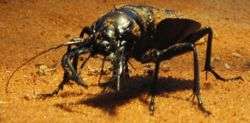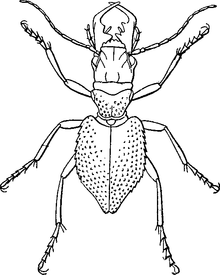Manticora (genus)
Manticora (often misspelled Mantichora (Latin term for "manticore") following an unjustified spelling change in 1837) is a well-known genus of tiger beetles that is endemic to Africa. Its members are the largest of the subfamily. All species are darkly colored, nocturnal, and flightless. Males usually have exaggerated mandibles compared to the females, used for clasping during copulation.
| Manticora tiger beetle | |
|---|---|
 | |
| Male Manticora scabra | |
| Scientific classification | |
| Kingdom: | |
| Phylum: | |
| Class: | |
| Order: | |
| Suborder: | |
| Family: | |
| Subfamily: | |
| Tribe: | Manticorini |
| Genus: | Manticora Fabricius, 1792 |
Taxonomy
This genus was among the first formally described by a pupil of Carl Linnaeus, Johan Christian Fabricius, in 1792.[1] The name Manticora comes from the ancient Persian for the legendary man-eating manticore. The first species of Manticora described was M. tuberculata, originally described by Charles De Geer in 1778 in the Linnean genus Carabus, to which it is only distantly related as presently defined. When Fabricius established Manticora he designated the species Carabus maxillosa, a junior synonym of M. tuberculata, as the type species.
Subsequently, numerous authors have described a number of additional species, subspecies, and variants, and the exact delimitation of taxa is highly disputed, with experts claiming as few as five species[2] and as many as 13[1], though it seems the latter number is highly artificial, and not based upon objective criteria or DNA analyses.[3]
Species
Manticora contains the following species (under the most ambitious scheme[1]; alternative classifications only recognize as few as 5 taxa[2]):
- Manticora congoensis Peringuey, 1888
- Manticora gruti Bouchard, 1892
- Manticora holubi Mareš, 2002
- Manticora imperator Mareš, 1976
- Manticora latipennis Waterhouse, 1837
- Manticora livingstoni Laporte de Castelnau, 1863
- Manticora mygaloides Thomson, 1859
- Manticora scabra Klug, 1849
- Manticora sicheli Thomson, 1859
- Manticora skrabali Mareš, 2000
- Manticora tibialis Boheman, 1848
- Manticora tuberculata Geer, 1778
- Manticora tyrannus Mareš, 2019
- Manticora werneri Mareš, 2000
Manticoras in folklore and popular culture

In African folklore manticoras are evil creatures, often accused of being responsible for many bad things. According to legend they are doombringers. Some tribes even personify Death as a manticora whose mandibles are an equivalent to the European scythe of death (Mareš, Lapáček, 1980).
In Jules Verne´s novel Dick Sand, A Captain at Fifteen, it is a Manticora beetle which helps Cousin Bénédict to escape from imprisonment, when the aforementioned, unguarded in a garden, follows the beetle. Since the beetle escapes from him by flying, it is possible that it is one of Verne's "scholar's jokes" (that is, a joke which only a scientist may recognize; see the entry Jules Verne) (Neff, 1978).
See also
References
- Mareš, Jaroslav (2002). Manticora: a monograph of the genus (Coleoptera, Cicindelidae, Manticorini). Taita Publishers. ISBN 978-8090273443.
- Oberprieler, Rolf G.; Arndt, Erik (2000). "On the biology of Manticora Fabricius (Coleoptera: Carabidae: Cicindelinae), with a description of the larva and taxonomic notes" (PDF). Tijschrift Voor Entomologie. 143: 71–89. Retrieved 20 November 2015.
- South African National Biodiversity Institute: assessment of Manticora conservation status
- (Beetles of Africa)
- (BioLib, Biological Library, a link to a page upon the Manticora genus
- "Manticora Fabricius, 1792". Carabidae of the World. 2011. Retrieved 29 June 2011.
- Ing Jaroslav Mareš, Vlastimil Lapáček, Nejkrásnější brouci tropů (The most beautiful tropical beetles), Prague, (1980)
- Ondřej Neff, Podivuhodný svět Julese Vernea (The Extraordinary World of Jules Verne), Prague, (1978)
| Wikispecies has information related to Manticora |
| Wikimedia Commons has media related to Manticora. |